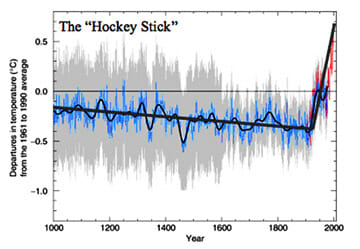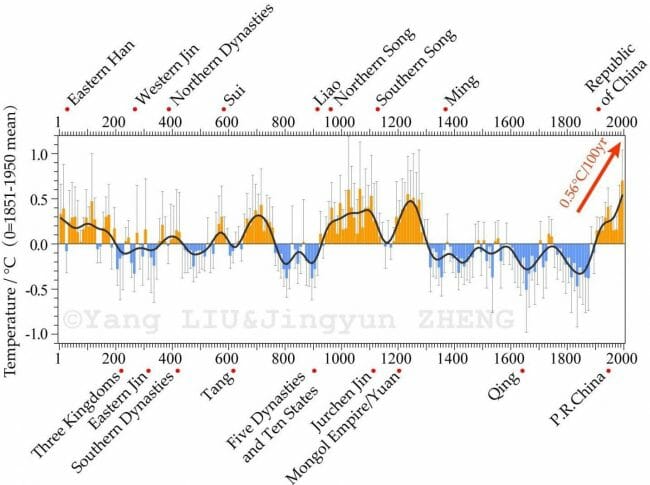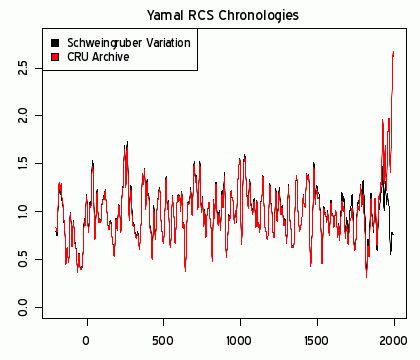Natural Climate Variability and Mann's Hockey Stick
Most folks even slightly acquainted with the climate debate have seen Dr. Mann's hockey stick. It is a historical temperature reconstruction using proxies such as the width of tree rings.
There were a zillion problems with this analysis, which I and many covered years ago and, frankly, I am past my tolerance in reiterating once again. Just to name three:
- The inflection of the hockey stick occurs right where two completely different data sets - proxies and actual thermometer readings -- have been grafted together, leading one to wonder if the inflection is a real natural phenomenon or instead related to differences in how the data was gathered
- The blue line, of the proxy data, ends in 1950. The reason for that is that the proxy data actually shows temperatures falling since 1950. This does not mean that temperatures actually fell - we are sure they have risen -- it means that the proxies are not very good proxies. If they are not following temperatures well in the last 50 years, why do we think they mirrored temperatures well in the 1000 years before that?
- As Steve McIntyre showed, while Mann used many proxies, his statistical method basically over-weighted a single data set from bristlecone pines in California and used techniques that were shown later to generate hockey sticks even from random noise.
Anyway, you can search Google and spend most of the day reading critiques and defenses of Mann.
But I think a lot of laymen missed the point of the analysis. Folks want to say that the hockey stick proves we have a big current spike in temperatures -- ie they focus on the blade of the hockey stick. But we already knew from surface temperature records that world temperatures have risen perhaps 0.8C over the last century. And besides, as mentioned above, Mann's proxy data does not even confirm or support the current working.
No, the "insight" of the hockey stick analysis was the handle -- the fact that until 1900, Mann was essentially claiming that temperatures had been 1) dead flat with limited variation and 2) consistently well below current temperatures. Prior to Mann's analysis, most scientists had a picture of past climate that had a warm period from 1000-1300 that was perhaps as warm as it is today followed by a cold period (called the medieval warm period and the little ice age). Most of this was based on historical analysis. Go to your local university and find a medieval historian. Going forward, universities will probably not teach any European history any more, but you probably can find a few old folks still hanging on via tenure. I took an audio course from Philip Daileader of William and Mary and he started his course on the high middle ages (1000-1300) by saying the most important fact of that period was the demographic expansion allowed in part by a warm and favorable climate. The warm climate allowed more food production as new areas, particularly in the north, could be brought into production. In turn, after 1300, Europe was met with a cooler and wetter climate that created a horrible famine in the 1320's, which in turn likely weakened the population and made the black death a few decades later all the worse. Later on, we have records of canals and rivers freezing across Europe that almost never freeze today. This colder period lasted until the early 19th century (I use 1812 as a break as I think of the freezing Russian winter of that year that sent Napoleon home without most of his army). Temperatures and sea levels began rising after that, long before man was burning fossil fuels in earnest.
This historical picture, shared by pretty much everyone until 20 years ago, was overturned by Mann. Look at his chart - no warm period in the middle ages, and no substantially colder period just afterwards. How did he refute the historical evidence, which is robust? He waved this evidence off as limited to Western Europe. Which was sort of funny, because most of his proxy data came from an even smaller area, the mountains east of Bishop, CA**.
So all this is a leadup to a new study out of China looking at temperature proxies for China. And it turns out China, which is on the other side of the world from the west (I know that because when Bugs Bunny digs straight down he always comes out in China), has pretty much the same temperature history everyone before Michael Mann thought we had in Europe.
**postscript: If you have a sports car, and want to drive a curving mountain road that does not have a lot of big cliffs and has pretty much zero other cars to get in the way, you might try Highway 168 from near Bishop up towards the ancient bristlecone pine forest.



